Lingaraj Temple: Odisha’s Architectural Marvel
The Lingaraj Temple is a Hindu temple dedicated to Shiva located in Bhubaneswar, Odisha, India. It is one of the oldest temples in the city and the most prominent landmark. The temple is considered to be one of the finest examples of Kalinga architecture, a style of temple architecture that originated in Odisha.

Contents
- 1 Lingaraj Temple History:
- 2 Legend of Lingaraj Temple:
- 3 Significance of Lingaraj Temple:
- 4 Myths of Lingaraj Temple:
- 5 Lingaraj Temple Architecture:
- 6 Lingaraj Temple Timing & Rituals:
- 6.0.1 Timings:
- 6.0.2 Nageshwar Jyotirlinga Dwaraka: 7th CE Temple with Divine Powers
- 6.0.3 Grishneshwar Temple: Wealth and Pleasure at Shiva’s Feet
- 6.0.4 Kedarnath Temple: One of Jyotirling & Char Dham
- 6.0.5 Trimbakeshwar Jyotirlinga Temple
- 6.0.6 Sacred Kashi Vishwanath Temple: 11th Jyotirling of Liberation
- 6.0.7 Aundha Nagnath Temple: 8th Jyothirling with Divine Serpents
- 7 Places to visit near Lingaraj Temple:
- 8 FAQ:
- 9 How to reach Lingaraj Temple:
- 10 Google Maps:
Lingaraj Temple History:
Foundational Years: While the exact date is debated, most accounts credit the temple’s construction to the 11th century, with King Yayati I of the Somavamsi dynasty playing a key role. There’s evidence suggesting parts of the temple existed as early as the 6th century CE, though.
Royal Builders: The temple’s present form is attributed to the Eastern Ganga dynasty. King Jajati Keshari, who shifted his capital to Bhubaneswar (then called Ekamra Kshetra), is believed to have initiated the project, with his successors completing it over the century.
Evolution over Time: The Lingaraja Temple wasn’t built all at once. The assembly hall (jagamohana), sanctum, and temple tower were constructed in the 11th century, while the hall of offering (bhoga-mandapa) came later in the 12th century.
Read More>> Tirumala Tirupati Venkateswara Swamy

Legend of Lingaraj Temple:
Shiva’s Favorite City: Lord Shiva supposedly told Parvati that he preferred Bhubaneswar (referred to as Ekamra Kshetra in some accounts) over the holy city of Varanasi.
Parvati’s Curious Exploration: Intrigued, Parvati disguised herself as a cowherd woman and ventured out to explore Bhubaneswar.
Demonic Encounter: During her exploration, Parvati encountered two demons, Kritti and Vasa, who were smitten by her and desired to marry her.
Parvati’s Power: Parvati refused their advances, and a fight ensued. The legend portrays Parvati as a powerful goddess who subdued and destroyed the demons.
Read More>> Shirdi Sai Baba Temple Maharashtra
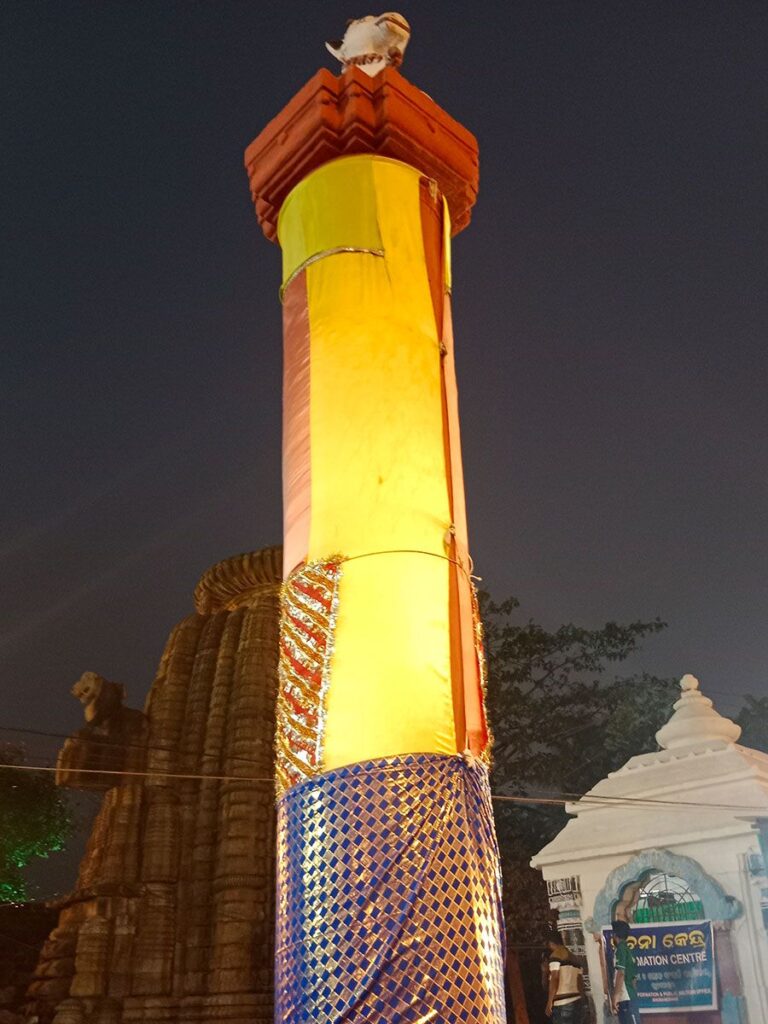
Significance of Lingaraj Temple:
Religious Importance: Dedicated to Lord Shiva, it’s a prominent pilgrimage site for Hindus, particularly those following Shaivism. The enshrined deity, Lingaraja, is considered a “Swayambhu” – a self-manifested Shiva linga. Here, Lord Shiva is worshipped as Tribhuvaneswara, meaning “Lord of the Three Worlds.”
Architectural Marvel: The temple exemplifies the Kalinga style of architecture, known for its intricate carvings and towering spires. It’s considered one of the finest examples of this style and a culmination of Bhubaneswar’s architectural heritage.
Historical Landmark: Dating back to the 11th century, the Lingaraja Temple offers a glimpse into Odisha’s past. Its construction and additions by successive rulers reflect the region’s history and artistic evolution.
Cultural Symbol: The temple is a major landmark in Bhubaneswar and a source of pride for Odisha. It serves as a center for local festivals like Shivaratri, attracting thousands of devotees and showcasing the vibrant cultural traditions of the state.
Read More>> Kamakhya Temple: The Tantric Temple of Mystery and Magic
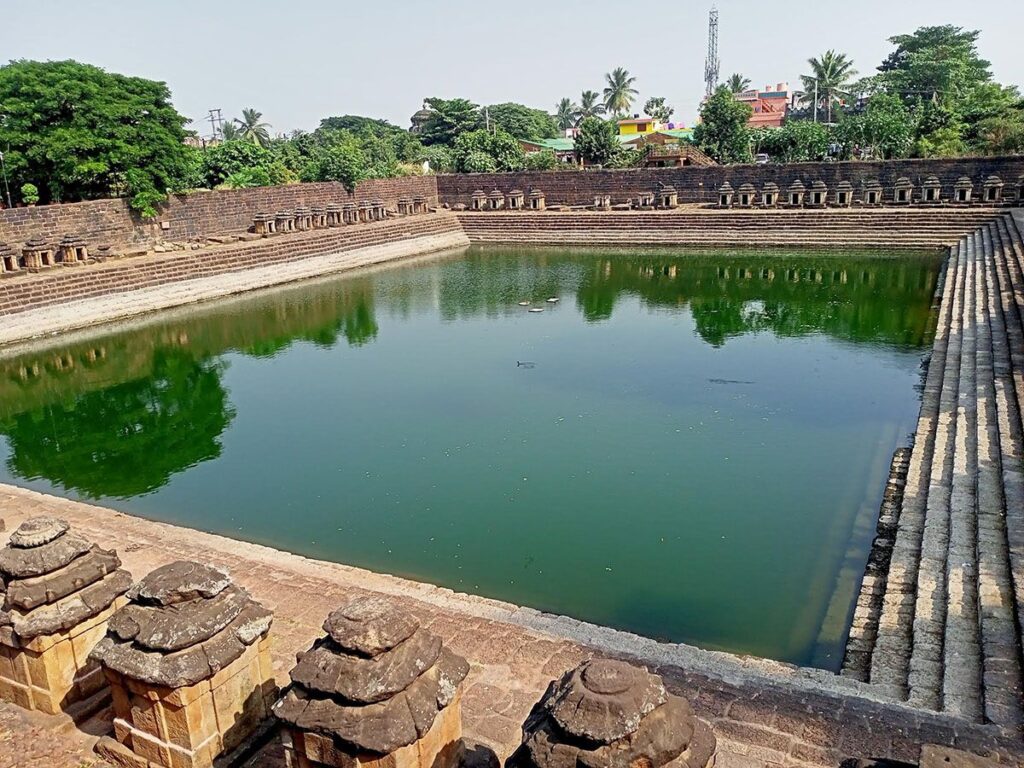
Myths of Lingaraj Temple:
The Underground River and Bindusagar: Legend says an underground river flows from the temple, filling the Bindusagar tank (meaning “ocean drop”). The water is believed to possess healing properties, curing both physical and spiritual ailments. Devotees consider taking a dip in the tank during festivals particularly auspicious.
Maa Parvati’s Anger and Procession: Another myth narrates a story about Maa Parvati, Lord Shiva’s consort. During a festival, Maa Parvati wished to stay in a specific temple (Rameswar deula) within the Lingaraja complex. When Lord Lingaraj refused, she got angry. Upon returning to the main temple, she is promised a grand boat festival procession for 21 days to appease her. This tradition is supposedly observed even today, culminating in their symbolic marriage at Kedar Gouri temple and Lord Lingaraj’s return in a grand procession.
Read More>> Narmada Devi Shondesh Shakti Peeth
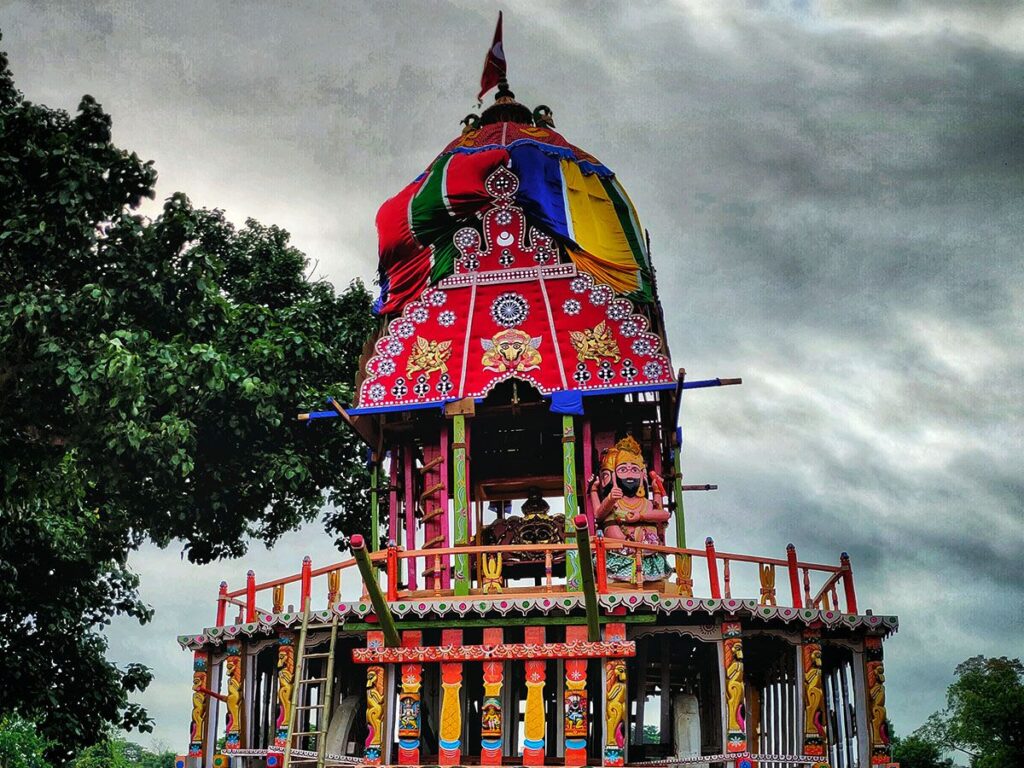
Lingaraj Temple Architecture:
- Kalinga Architecture: The Lingaraj Temple represents the Kalinga style of architecture, which flourished in the region of Odisha (formerly known as Kalinga). This style is characterized by its unique blend of pyramidical roofs, intricate carvings, and imposing gateways.
- Deul and Jagamohana: The Lingaraj Temple follows the typical Odishan temple plan, consisting of two main structures – the sanctum sanctorum or “Deul” and the assembly hall or “Jagamohana”. The Deul is a towering structure with a spire (shikara) that dominates the temple complex. The Jagamohana, also known as the “Mukhasala”, is the assembly hall where devotees gather for prayers and rituals.
- Sandstone and Laterite Construction: The temple is predominantly constructed using sandstone and laterite stone, which are abundantly available in the region. These materials provide durability and are conducive to intricate carving work.
- Sculptural Marvels: The Lingaraj Temple is renowned for its exquisite sculptural embellishments. The outer walls of the temple are adorned with intricate carvings depicting various deities, celestial beings, mythical creatures, and scenes from Hindu mythology. The carvings are meticulously crafted and showcase the artistic prowess of the ancient Odishan artisans.
- Mukhasala: The Jagamohana or Mukhasala of the Lingaraj Temple is particularly noteworthy for its architectural grandeur. It features a pyramidal roof supported by elaborately carved pillars. The entrance porch is adorned with intricate carvings of celestial beings, musicians, dancers, and mythological motifs.
- Nata Mandira and Bhoga Mandapa: Adjacent to the main temple complex, there are additional structures such as the Nata Mandira (dance hall) and Bhoga Mandapa (offering hall). These structures serve as venues for religious ceremonies, cultural performances, and community gatherings.
- Temple Tank: The Lingaraj Temple complex also includes a sacred tank known as the “Bindusagar Tank”. Devotees believe that taking a dip in the holy waters of the tank purifies the soul and bestows blessings.
Lingaraj Temple Timing & Rituals:
Timings:
The temple is open every day for darshan (visit) following a two-session schedule:
Morning session: 6:00 AM to 12:30 PM
Afternoon session: 3:30 PM to 9:00 PM
Rituals: While specific timings for daily rituals might vary, here’s a general idea:
The temple conducts several pujas (prayers) throughout the day, but timings are subject to change.
Major festivals like Maha Shivratri involve elaborate rituals with specific schedules. These schedules are usually announced by the temple administration beforehand and might differ slightly each year.
Places to visit near Lingaraj Temple:
- Bindusagar Tank: Adjacent to the Lingaraj Temple, the Bindusagar Tank is a sacred water body considered holy by devotees. It’s a serene spot for a peaceful stroll and offers a picturesque view of the temple.
- Rajarani Temple: Located just a short distance from Lingaraj Temple, the Rajarani Temple is renowned for its intricate carvings and sculptural beauty. It’s dedicated to Lord Shiva and is known for its unique architectural style.
- Mukteshwar Temple: Another architectural marvel in close proximity to Lingaraj Temple is the Mukteshwar Temple. It’s known for its beautifully carved arched gateway and intricate sculptures depicting various Hindu deities.
- Khandagiri and Udayagiri Caves: These ancient rock-cut caves are situated a short distance from Bhubaneswar and offer a glimpse into Odisha’s rich history. The caves feature intricate carvings, inscriptions, and Jain sculptures dating back to the 2nd century BCE.
- Nandankanan Zoological Park: If you’re interested in wildlife and nature, Nandankanan Zoological Park is a must-visit attraction near Bhubaneswar. It’s home to a diverse range of flora and fauna, including rare and endangered species like white tigers and Asiatic lions.
- Dhauli Shanti Stupa: Located on the outskirts of Bhubaneswar, Dhauli Shanti Stupa is a Buddhist monument built atop Dhauli Hill. It commemorates the Kalinga War and is a symbol of peace and non-violence.
- Odisha State Museum: For those interested in history and culture, the Odisha State Museum is worth a visit. It houses a vast collection of artifacts, sculptures, manuscripts, and archaeological findings that shed light on Odisha’s rich heritage.
- Ekamra Kanan Botanical Gardens: If you’re looking for a tranquil escape from the city’s hustle and bustle, Ekamra Kanan Botanical Gardens offers lush greenery, landscaped gardens, and a peaceful ambiance for nature lovers.
Read More>> Arupadai veedu | Six Abodes of Lord Murugan
FAQ:
- What is the Lingaraj Temple?
- The Lingaraj Temple is a prominent Hindu temple dedicated to Lord Shiva, located in Bhubaneswar, Odisha, India. It is one of the most significant temples in Odisha and is renowned for its architectural grandeur and religious significance.
- What is the history of Lingaraj Temple?
- The Lingaraj Temple dates back to the 11th century and is believed to have been built during the reign of the Somavamsi dynasty. It is an iconic symbol of Odishan architecture and Hindu spirituality, with a rich history steeped in mythology and tradition.
- What is the significance of Lingaraj Temple?
- The Lingaraj Temple holds immense religious significance for devotees of Lord Shiva. It is considered a sacred pilgrimage site and is believed to be one of the holiest places to worship Lord Shiva in his lingam form. The temple also attracts tourists and scholars interested in ancient architecture and Hindu culture.
- What are the timings and entry fees for Lingaraj Temple?
- The temple is usually open for devotees and visitors from early morning to late evening. The exact timings may vary depending on religious rituals and festivals. As of my last update, there is no entry fee to visit the temple, but donations are appreciated for maintenance and upkeep.
- What are the dress code and rules for visiting Lingaraj Temple?
- Visitors are required to adhere to a modest dress code when entering the temple premises. Both men and women are expected to dress conservatively, covering their shoulders and knees. Additionally, shoes are not allowed inside the temple complex, and photography may be restricted in certain areas.
- What are the festivals celebrated at Lingaraj Temple?
- The Lingaraj Temple observes various festivals throughout the year, with Maha Shivaratri being the most significant. During this festival, devotees flock to the temple to offer prayers and seek blessings from Lord Shiva. Other festivals such as Kartik Purnima, Ashokastami, and Rath Yatra are also celebrated with fervor.
- Are there any nearby attractions to visit along with Lingaraj Temple?
- Yes, there are several other attractions near Lingaraj Temple, including the Rajarani Temple, Mukteshwar Temple, Khandagiri and Udayagiri Caves, and Dhauli Shanti Stupa. These sites offer a glimpse into Odisha’s rich cultural heritage and architectural marvels.
- Is there accommodation available near Lingaraj Temple?
- Bhubaneswar offers a range of accommodation options to suit various budgets, including hotels, guesthouses, and lodges. Many hotels are located in close proximity to Lingaraj Temple, making it convenient for visitors to explore the area.
How to reach Lingaraj Temple:
- By Air: Bhubaneswar is served by the Biju Patnaik International Airport (BBI), located approximately 5-6 kilometers from the city center. From the airport, you can hire a taxi or use app-based ride-hailing services to reach Lingaraj Temple. The journey typically takes around 20-30 minutes, depending on traffic conditions.
- By Train: Bhubaneswar Railway Station is a major railway junction and is well-connected to various cities across India. From the railway station, you can hire a taxi, auto-rickshaw, or use public buses to reach Lingaraj Temple. The temple is located about 3-4 kilometers from the railway station, and the journey takes around 15-20 minutes by road.
- By Bus: Bhubaneswar has a well-established bus network with regular services to neighboring towns and cities. The Lingaraj Temple is easily accessible by public buses, and there are several bus stops located near the temple complex. You can check with the local bus authorities or use navigation apps to find the most convenient bus route to reach the temple.
- By Taxi or Auto-rickshaw: Taxis and auto-rickshaws are readily available throughout Bhubaneswar and offer a convenient mode of transportation to reach Lingaraj Temple. You can either hire them directly from your location or use app-based ride-hailing services for added convenience.



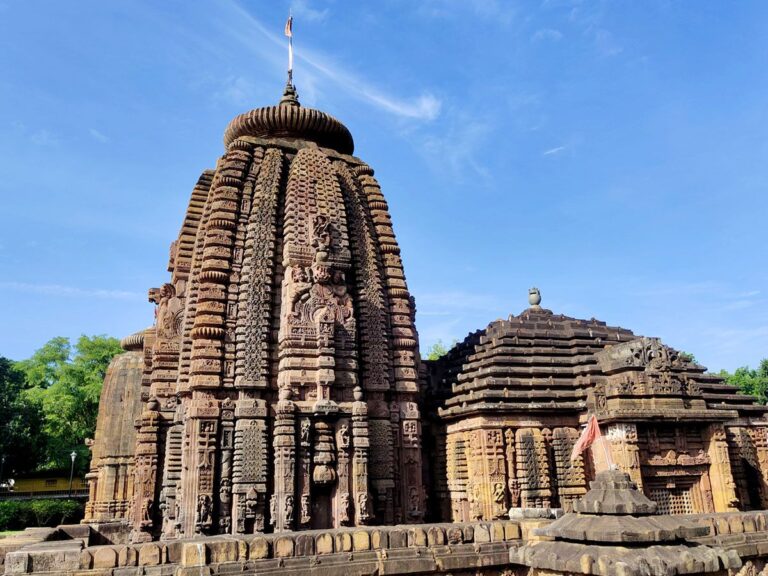

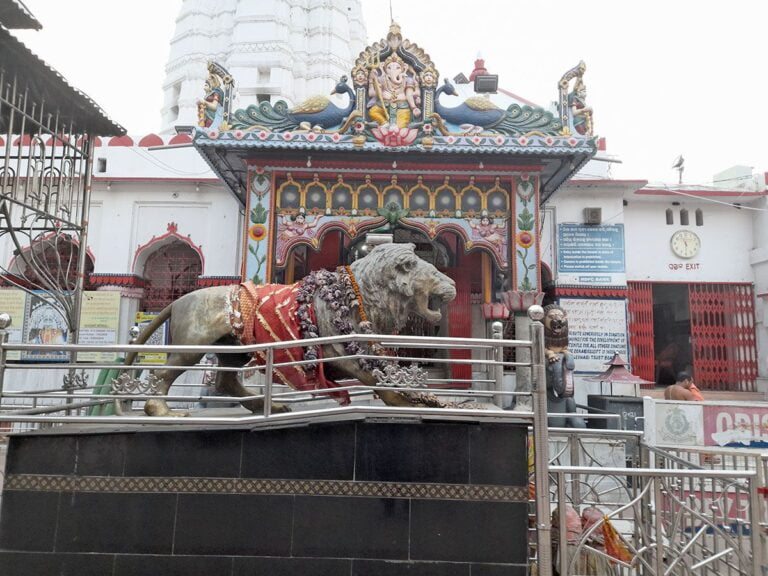






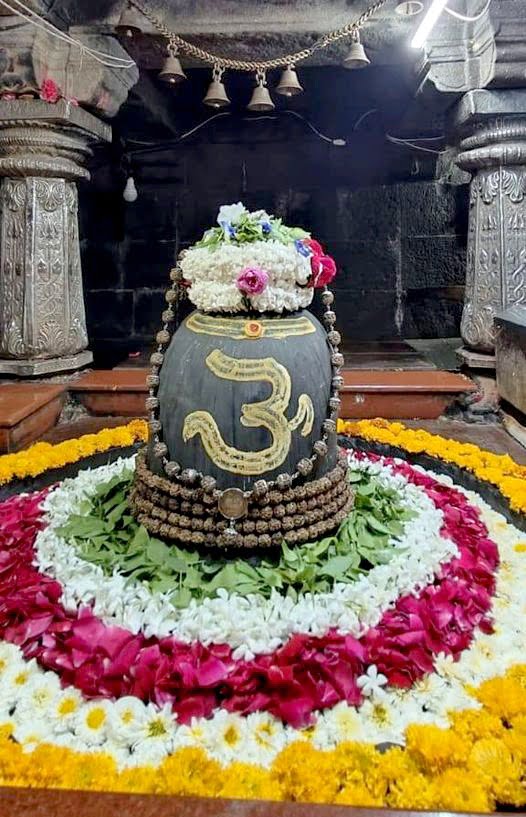
7 Comments